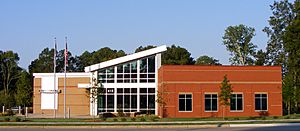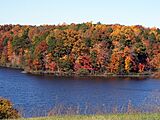Butner, North Carolina facts for kids
Quick facts for kids
Butner, North Carolina
|
||
|---|---|---|

Butner Town Hall
|
||
|
||

Location of Butner, North Carolina
|
||
| Country | United States | |
| State | North Carolina | |
| County | Granville | |
| Founded | 1942 | |
| Incorporated | November 1, 2007 | |
| Named for | Henry W. Butner | |
| Area | ||
| • Total | 14.05 sq mi (36.39 km2) | |
| • Land | 14.03 sq mi (36.33 km2) | |
| • Water | 0.03 sq mi (0.06 km2) | |
| Elevation | 361 ft (110 m) | |
| Population
(2020)
|
||
| • Total | 8,397 | |
| • Density | 598.67/sq mi (231.15/km2) | |
| Time zone | UTC-5 (Eastern (EST)) | |
| • Summer (DST) | UTC-4 (EDT) | |
| ZIP code |
27509
|
|
| Area code(s) | 919 | |
| FIPS code | 37-09360 | |
| GNIS feature ID | 2424932 | |
Butner is a town in Granville County, North Carolina, United States. It is located in the central part of North Carolina. In 2020, about 8,397 people lived there. For many years, the state of North Carolina managed Butner. It became an official town in 2007.
Contents
History of Butner
Butner officially became a town on November 1, 2007. Governor Mike Easley signed the bill that made it a town.
The town is built on the land of a former U.S. Army camp. This camp was called Camp Butner. It was named after Major General Henry W. Butner. He was a famous person from North Carolina.
Geography and Location
Butner is in the southwestern part of Granville County. A major highway, Interstate 85, runs through the town. This highway helps people travel to nearby cities. You can reach Oxford, the county seat, by driving about 16 miles northeast. Durham is about 13 miles southwest.
The town covers an area of about 14 square miles (36 square kilometers). Only a very small part of this area is water.
Population and People
| Historical population | |||
|---|---|---|---|
| Census | Pop. | %± | |
| 1970 | 3,538 | — | |
| 1980 | 4,240 | 19.8% | |
| 1990 | 4,679 | 10.4% | |
| 2000 | 5,792 | 23.8% | |
| 2010 | 7,591 | 31.1% | |
| 2020 | 8,397 | 10.6% | |
| 2022 (est.) | 8,566 | 12.8% | |
| U.S. Decennial Census | |||
Butner has grown quite a bit over the years. In 2010, there were 7,591 people living in the town. By 2020, the population had increased to 8,397 people.
Who Lives in Butner?
In 2020, there were 8,397 people living in Butner. These people lived in 2,865 households. The town is home to a mix of different groups. About 40.74% of the people were White. Around 31.71% were Black or African American. About 22.79% of the population was Hispanic or Latino.
Life in Butner
In 2010, about 33% of households had children under 18. The average household had about 2.74 people. The town's population included people of all ages. About 26% were under 18 years old. Around 10.4% were 65 years or older.
The average income for a household in Butner was about $45,437. This shows the economic well-being of the town's residents.
Important Facilities
The area around Butner has several important facilities. These include training centers and other state-run organizations.
- Camp Butner Training Center: This center is run by the North Carolina National Guard. It covers about 5,000 acres.
- Federal Correctional Complex, Butner: This complex includes several federal facilities. It also has a medical center.
- Polk Correctional Institution: This is a state facility. It is part of the North Carolina Department of Correction.
- C.A. Dillon Youth Development Center: This center helps young people. It is part of the North Carolina Department of Public Safety.
- North Carolina Department of Health and Human Services facilities: These include centers like Murdoch Developmental Center and Central Regional Hospital. They provide important health and development services.
See also
In Spanish: Butner (Carolina del Norte) para niños





